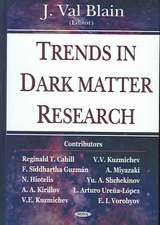Progress in Dark Matter Research
Editat de J. Val Blainen Limba Engleză Hardback – 8 sep 2005
Preț: 1158.26 lei
Preț vechi: 1484.09 lei
-22% Nou
Puncte Express: 1737
Preț estimativ în valută:
221.64€ • 229.00$ • 184.38£
221.64€ • 229.00$ • 184.38£
Carte disponibilă
Livrare economică 26 februarie-12 martie
Preluare comenzi: 021 569.72.76
Specificații
ISBN-13: 9781594542435
ISBN-10: 1594542430
Pagini: 255
Ilustrații: tables & charts
Dimensiuni: 184 x 261 x 28 mm
Greutate: 0.78 kg
Editura: Nova Science Publishers Inc
ISBN-10: 1594542430
Pagini: 255
Ilustrații: tables & charts
Dimensiuni: 184 x 261 x 28 mm
Greutate: 0.78 kg
Editura: Nova Science Publishers Inc
Cuprins
Preface; Little Black Holes as Dark Matter Candidates with Feasible Cosmic and Terrestrial Interactions; Enlightening the Dark Universe at Galactic Scales; A Quantum Approach to Dark Matter; The Local Dark Matter; Indirect Search for Cold Dark Matter by Imaging Atmospheric Cherenkov Telescope; Quests for Fats: Roles for a Fat Dark Matter -- WIMPZILLA; Distribution of Mass in Galaxy Cluster CL0024 and the Particle Mass of Dark Matter; The Dark Matter and Radiation Backgrounds Predicted from a New Principle and a New Gravitational Theory; Index.



















